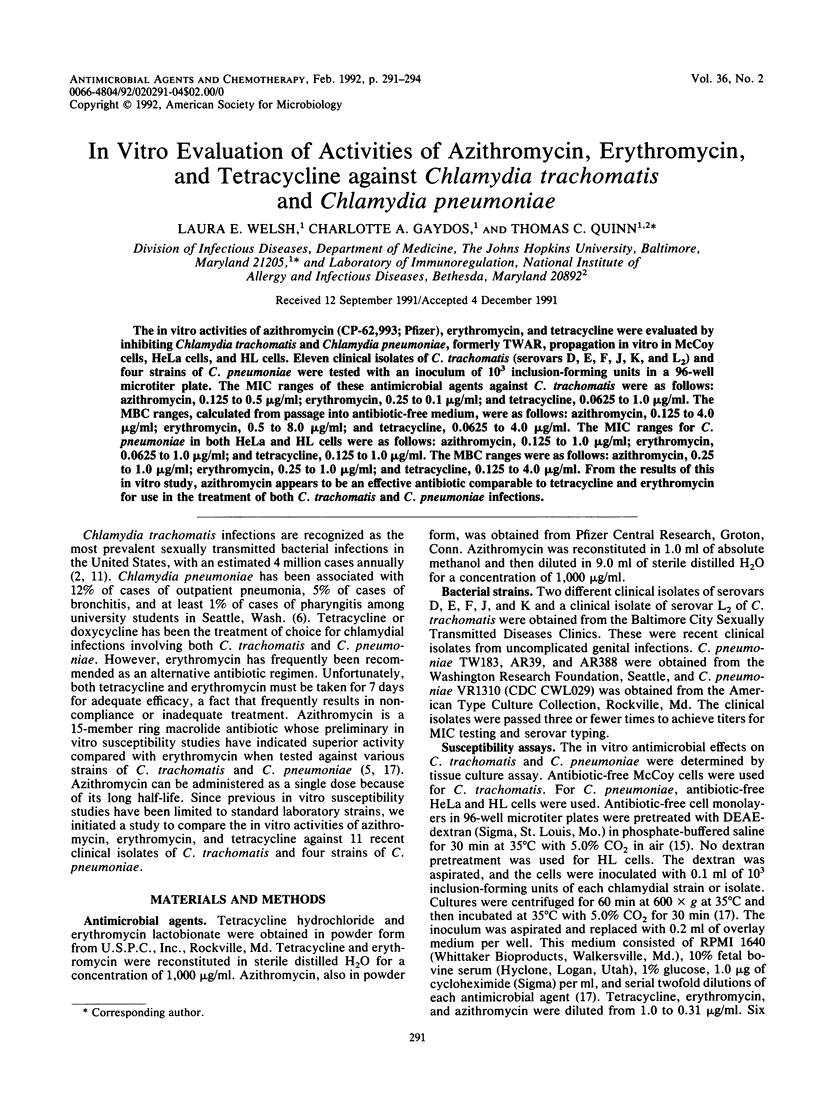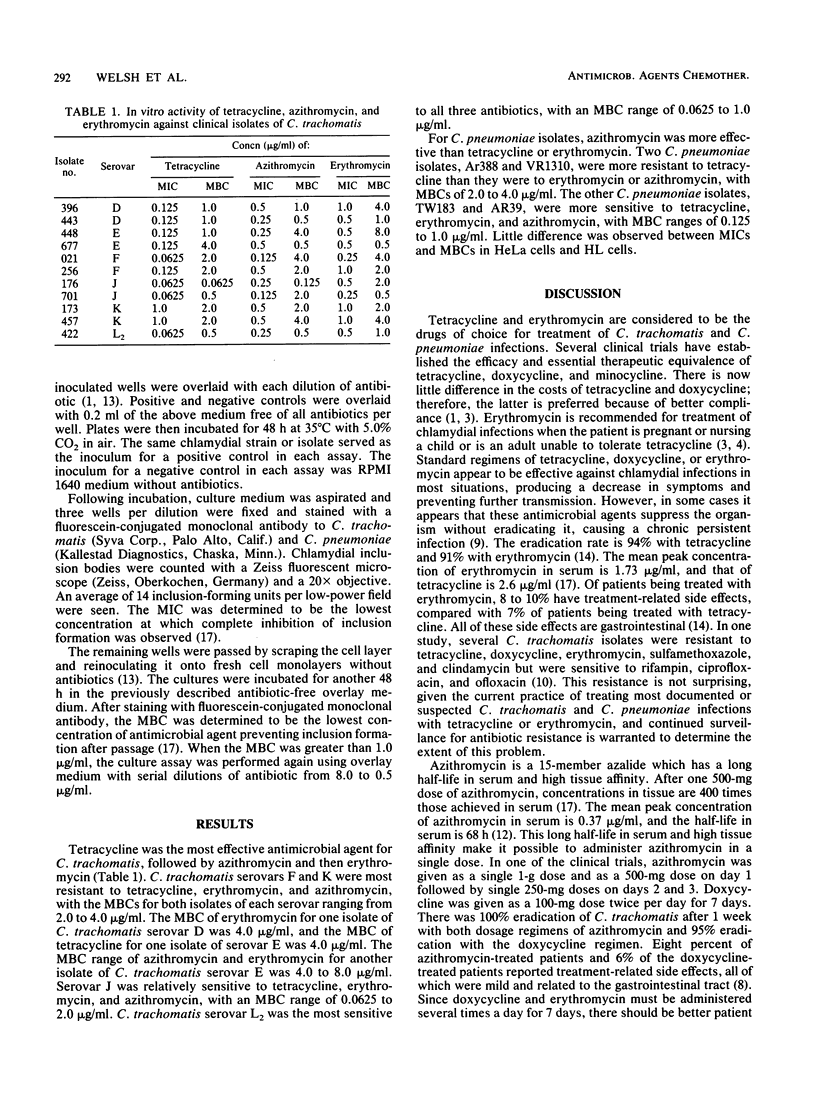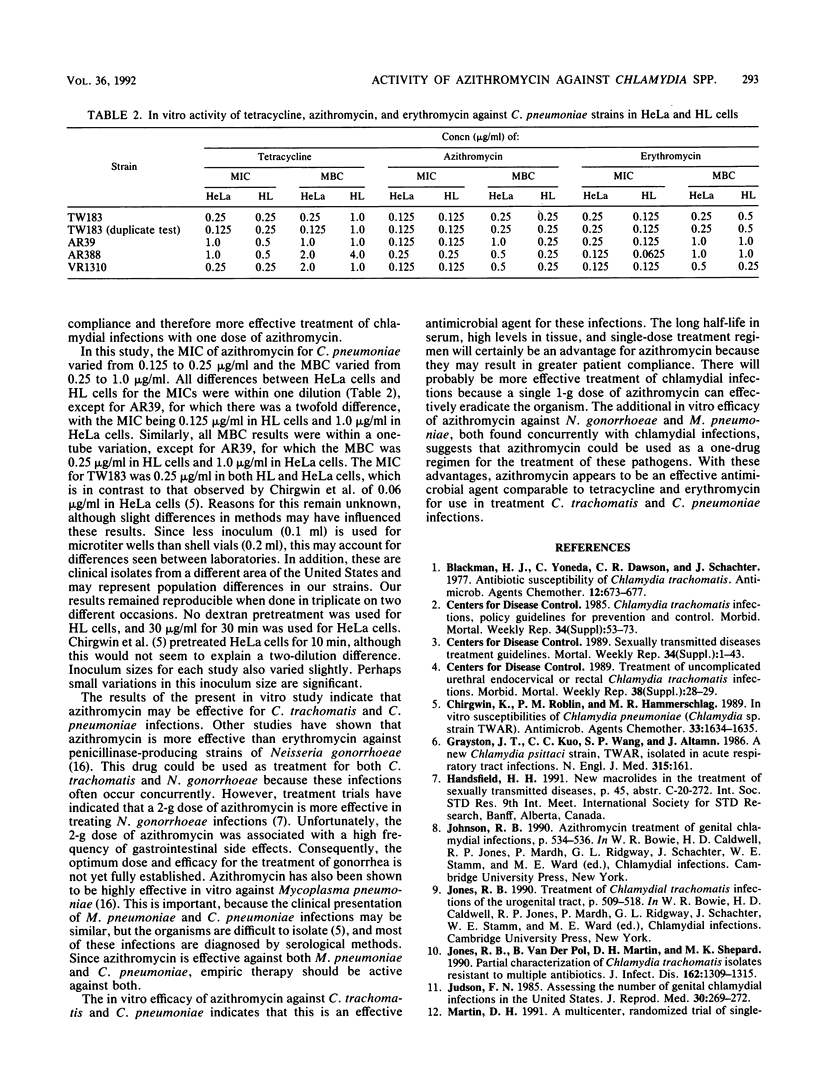Abstract
The in vitro activities of azithromycin (CP-62,993; Pfizer), erythromycin, and tetracycline were evaluated by inhibiting Chlamydia trachomatis and Chlamydia pneumoniae, formerly TWAR, propagation in vitro in McCoy cells, HeLa cells, and HL cells. Eleven clinical isolates of C. trachomatis (serovars D, E, F, J, K, and L2) and four strains of C. pneumoniae were tested with an inoculum of 10(3) inclusion-forming units in a 96-well microtiter plate. The MIC ranges of these antimicrobial agents against C. trachomatis were as follows: azithromycin, 0.125 to 0.5 microgram/ml; erythromycin, 0.25 to 0.1 microgram/ml; and tetracycline, 0.0625 to 1.0 microgram/ml. The MBC ranges, calculated from passage into antibiotic-free medium, were as follows: azithromycin, 0.125 to 4.0 micrograms/ml; erythromycin, 0.5 to 8.0 micrograms/ml; and tetracycline, 0.0625 to 4.0 micrograms/ml. The MIC ranges for C. pneumoniae in both HeLa and HL cells were as follows: azithromycin, 0.125 to 1.0 micrograms/ml; erythromycin, 0.0625 to 1.0 microgram/ml; and tetracycline, 0.125 to 1.0 microgram/ml. The MBC ranges were as follows: azithromycin, 0.25 to 1.0 microgram/ml; erythromycin, 0.25 to 1.0 microgram/ml; and tetracycline, 0.125 to 4.0 micrograms/ml. From the results of this in vitro study, azithromycin appears to be an effective antibiotic comparable to tetracycline and erythromycin for use in the treatment of both C. trachomatis and C. pneumoniae infections.
Full text
PDF



Selected References
These references are in PubMed. This may not be the complete list of references from this article.
- Blackman H. J., Yoneda C., Dawson C. R., Schachter J. Antibiotic susceptibility of Chlamydia trachomatis. Antimicrob Agents Chemother. 1977 Dec;12(6):673–677. doi: 10.1128/aac.12.6.673. [DOI] [PMC free article] [PubMed] [Google Scholar]
- Chirgwin K., Roblin P. M., Hammerschlag M. R. In vitro susceptibilities of Chlamydia pneumoniae (Chlamydia sp. strain TWAR). Antimicrob Agents Chemother. 1989 Sep;33(9):1634–1635. doi: 10.1128/aac.33.9.1634. [DOI] [PMC free article] [PubMed] [Google Scholar]
- Grayston J. T., Kuo C. C., Wang S. P., Altman J. A new Chlamydia psittaci strain, TWAR, isolated in acute respiratory tract infections. N Engl J Med. 1986 Jul 17;315(3):161–168. doi: 10.1056/NEJM198607173150305. [DOI] [PubMed] [Google Scholar]
- Jones R. B., Van der Pol B., Martin D. H., Shepard M. K. Partial characterization of Chlamydia trachomatis isolates resistant to multiple antibiotics. J Infect Dis. 1990 Dec;162(6):1309–1315. doi: 10.1093/infdis/162.6.1309. [DOI] [PubMed] [Google Scholar]
- Judson F. N. Assessing the number of genital chlamydial infections in the United States. J Reprod Med. 1985 Mar;30(3 Suppl):269–272. [PubMed] [Google Scholar]
- Mourad A., Sweet R. L., Sugg N., Schachter J. Relative resistance to erythromycin in Chlamydia trachomatis. Antimicrob Agents Chemother. 1980 Nov;18(5):696–698. doi: 10.1128/aac.18.5.696. [DOI] [PMC free article] [PubMed] [Google Scholar]
- Scheibel J. H., Kristensen J. K., Hentzer B., Secher L., Ullman S., Verdich J., Weismann K. Treatment of chlamydial urethritis in men and Chlamydia trachomatis-positive female partners: comparison of erythromycin and tetracycline in treatment courses of one week. Sex Transm Dis. 1982 Jul-Sep;9(3):128–131. doi: 10.1097/00007435-198207000-00005. [DOI] [PubMed] [Google Scholar]
- Stamm W. E., Tam M., Koester M., Cles L. Detection of Chlamydia trachomatis inclusions in Mccoy cell cultures with fluorescein-conjugated monoclonal antibodies. J Clin Microbiol. 1983 Apr;17(4):666–668. doi: 10.1128/jcm.17.4.666-668.1983. [DOI] [PMC free article] [PubMed] [Google Scholar]
- Waites K. B., Cassell G. H., Canupp K. C., Fernandes P. B. In vitro susceptibilities of mycoplasmas and ureaplasmas to new macrolides and aryl-fluoroquinolones. Antimicrob Agents Chemother. 1988 Oct;32(10):1500–1502. doi: 10.1128/aac.32.10.1500. [DOI] [PMC free article] [PubMed] [Google Scholar]
- Walsh M., Kappus E. W., Quinn T. C. In vitro evaluation of CP-62,993, erythromycin, clindamycin, and tetracycline against Chlamydia trachomatis. Antimicrob Agents Chemother. 1987 May;31(5):811–812. doi: 10.1128/aac.31.5.811. [DOI] [PMC free article] [PubMed] [Google Scholar]


